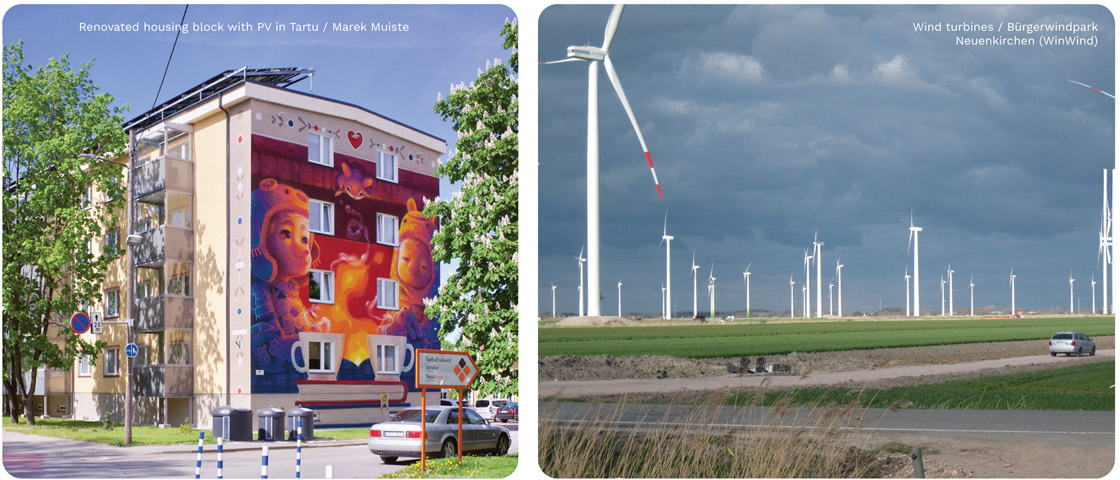Climate neutrality by 2050 and – with the Fit for 55 Package – an increased target to produce 40% of energy from renewable sources by 2030: these are the EU’s ambitious targets in the face of the global climate emergency.
Achieving them will require a sharp increase in the deployment of renewables, which means that such technologies will need to, inevitably, become ever more present, visible and available in the daily lives of Europe’s citizens. Not everyone is equally happy about this. While there is a general consensus in the EU that we need more renewable energy to tackle climate change, opposition to new infrastructure – in particular photovoltaic and wind turbine sites – is signifi cant. Despite political commitments for more renewables, local protests lead to signifi cant delays in siting procedures, sometimes for years on end. Too often, local communities perceive new renewable energy projects as a threat and disruption rather than an opportunity.
It does not have to be this way. All over Europe, renewable energy community projects are materializing, which involve local communities, for example by enabling citizens to invest directly, or by channeling revenue into local foundations for social projects. At the centre of all of this: municipalities with an inherent interest, not only in meeting their own renewable energy targets, but also, in promoting social inclusion. Not least fueled by the recast Renewable Energy Directive (RED II- 2018/2001/ EU), renewable energy communities have been creating a sense of ownership of local renewable energy sources, ensuring that local communities benefi t, all the while resulting in more citizen engagement, lower energy bills and the alleviation of energy poverty. Whether on city rooftops, fi elds around rural communities, or on remote islands, citizens are increasingly organizing themselves into energy communities; producing, consuming and selling their own energy. In fact, by 2050, a full half of European citizens could be producing their own electricity, meeting 45% of the energy demand in the EU – if citizens receive adequate support in taking this up.
In many cases, local governments are taking on key roles: by guiding citizens and SMEs in setting up energy communities, becoming shareholders, acting as energy community springboards, and more. With their political mandates and proximity to citizens, they are in the best position to make energy communities a prevalent and powerful reality. In particular, the involvement of local governments – coupled with community ownership models – often lead to higher levels of trust and identifi cation with the projects.
In the Municipality of Neuenkirchen (Germany), some citizens initially voiced their concerns about the plans for the community wind farm. However, social acceptance soon improved with opportunities for citizens to participate directly by buying shares and becoming partners in the project, as well as benefi t via local tax revenue, new job openings, and the establishment of a civic non-profi t association, which receives 1% of the wind farm’s annual gross remuneration (funding community buses, a church renovation and more).
The municipality also obtained shares of approximately 20,000 Euros in the wind farm (the legal maximum allowed), showing its commitment to and trust in the project. Without the engagement of the local government, this project would likely never have become the best-practice example it is today.
Some European cities are also turning to energy community approaches to alleviate energy poverty. Tartu (Estonia), has made energy poverty alleviation a cornerstone of its Sustainable Energy & Climate Action Plan and is turning existing housing associations into renewable energy communities, with strong support from the Tartu Regional Energy Agency, by combining the installation of photovoltaic rooftop panels with deep housing-block renovations. As a result, home-owners are gaining access to renewable energy subsidies, improving their homes’ energy effi ciency and saving on energy costs. The communities are able to generate an additional income stream by selling their energy to the national grid. With paintings on the housing walls by local as well as international artists, the establishment of these energy transition projects is leading to an increased sense of identifi cation with these local renewable energy sources, greater local awareness and more citizen engagement. The next steps within the EU-funded DECIDE project supporting this transition are to measure the energy consumption in these housing blocks, and evaluate and model the size of further photovoltaic installation.
While municipalities are increasingly active in encouraging citizens to participate in the energy transition, the EU-funded COME RES project, which aims to advance renewable energy communities as per the EU's recast Renewable Energy Directive (RED II), has highlighted that most current member state-level regulatory frameworks and relevant support schemes are not conducive enough to community energy projects.
It is important to note here that the transposition deadline for RED II – which specifi cally calls upon member states to build the capacity of public authorities so that they can better support the uptake of RECs – has already passed (end June 2021). Therefore, although there are clearly ways that cities and local governments can currently support energy communities, for the EU to be able to deploy renewable technologies at the scale required to achieve its ambitious targets, national legislators must act. It is essential that they swiftly and thoroughly transpose and implement RED II, create concrete targets for renewable energy communities and set up the relevant enabling frameworks and support schemes.
